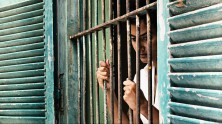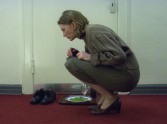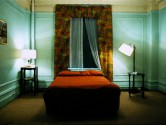
Breathing Through Cinema
The Films of Chantal Akerman
Nothing is simple, and whenever I say anything, I want to say the opposite as well.
That statement, spoken by Chantal Akerman in a 2011 interview with film theorist Nicole Brenez, functions neatly as an off-the-cuff summary of one particular, prevalent conception of an artist’s purpose, one that assumes dialectical thought—as opposed to Platonic conceptual purity—to be a precondition for dynamically and meaningfully engaging with the world. For Akerman to profess this was not for her to be intentionally provocative or evasive; if anything, the legendary filmmaker’s interviews, like her films, were always marked by a striving for the ideal means with which to express complicated ideas, as if oversharing were the only route to truth. Rather, it’s more likely that in this casual instance of self-analysis, she happened to stumble across her entire philosophy and practice as a filmmaker.
Akerman’s inclination toward scrutinizing her own impulses, ideas and expressions, which is evident everywhere from her crossing of seemingly incompatible modes (avant-garde minimalism and the musical, for instance) to the dissonances she often creates between sound and image, sprang from her upbringing. As a restlessly curious teenager in Paris in the late sixties, she attended classes at a Jewish learning center where, under the tutelage of philosopher Emmanuel Lévinas, she “learn[ed] the art of questioning and negation,” a skill no doubt reinforced by her experiences eavesdropping on Jacques Lacan and Gilles Deleuze lectures at the University of Paris. Together with her trips to Anthology Film Archives in early 1970s New York, where she persisted for several years on odd jobs and independent initiative, these miscellaneous educational whims substituted for a traditional college education, which Akerman ditched in her hometown of Brussels after less than a year of unfulfilling degree work.
These formative years may appear to paint Akerman as an inheritor of privilege, hopscotching around the world’s cultural capitols without much in the way of practical resistance, but in fact the opposite was true. The director’s parents were exiled Polish Jews who were forced to scrape together an impoverished existence in Brussels, and, as Akerman recalled, “I understood right away that my parents had nothing, that I couldn’t have anything or ask for anything.” Of particular significance was her mother’s years of hardship in concentration camps, a devastating fact that essentially provides one of the tectonic plates of Akerman’s entire oeuvre. As much as Akerman would go on to value the role of questioning, it was in the primordial history of her parents that she would be acclimatized to the absolute limits of questioning in the face of real trauma. Her heightened awareness of her mother’s trials—coupled with her inability to ever know the exact nature of them—produced an acute sense of identity crisis, so that even when Akerman was eventually traveling the world making films, covering such far-flung material as border relations in the southwestern United States or the goings-on in a cheap motel in Manhattan, the work always, implicitly or not, circled back homeward to questions of belonging.
The films produced in the first decade of Akerman’s career—many of which were self-financed, limited to a few locations, and made with only the slimmest of cast and crew—bear out the development of formal strategies analogous to her humble beginnings. Though it was Jean-Luc Godard’s madcap Pierrot le Fou that allegedly spurred Akerman’s cinematic bug, it was the structuralist and minimalist avant-gardes in vogue in New York in the seventies—which encompassed such filmmakers as Yvonne Rainer, Michael Snow and Andy Warhol—that were really instrumental in empowering her sensibilities. To an individual already predisposed to thinking within her means, the stationary long take and the avoidance of overtly dramatic spectacle or music cues were natural and cost-effective inheritances, while a fast-evolving fixation on the routine and the mundane stood out quickly as her distinguishing feature. In films such as Je tu il elle, Hotel Monterey, and News From Home, the inexorable fact of time and space provided drama enough for Akerman, who happily dispensed with plot and characterization in favor of confronting the viewer with the physical world’s presence at supreme length.
Longest of all is Jeanne Dielman, an over-three-hour catalogue of crushingly banal domesticity featuring Akerman’s first star subject in Delphine Seyrig, and a film that now holds secure footing as a watershed moment in structuralist cinema and feminist expression alike. The film, which dedicates untold spans of time to recording Seyrig as she silently and fastidiously performs the round-the-clock labors of a stay-at-home mother in between covert prostitution gigs, became a cause célèbre in art-film circles in the decade after its completion and continues to be synonymous with Akerman’s legacy, for better and for worse. While the film represents the most ambitious and rewarding synthesis of the director’s touchstones as an artist (her real-time experimentation, her focus on the quotidian, her elevation of women’s underrepresented struggles), its centrality in her body of work also tends to attach her to the labels—“minimalist,” “feminist”—that she was always so vigilant in rejecting, and which the many obituaries produced in the wake of her recent death prove are still operative.
A more holistic survey of Akerman’s career reveals just how early and often she branched off from this foundation, and indeed how frequently her work complicated it. If Jeanne Dielman’s asceticism posed the possibility of a director with limited range, then disparate accomplishments such as Toute une Nuit (a hyper-eventful mosaic of romantic vignettes), Golden Eighties (an eccentric musical set inside a shopping mall), and La Captive (an elegant Hitchcockian adaptation of notoriously “unadaptable” Marcel Proust) refuted any such suspicions. And where Jeanne Dielman showed an artist with a near-obsessive interest in the mini-universe of a single apartment, later documentaries like D’Est (about the migration of Europeans after the fall of the Iron Curtain), Sud (about a hate crime committed in Texas), and La Bas (which evokes tensions between Israel and Palestine by observing the hum of street life beyond the windows of a Tel Aviv hotel room) revealed a human with a profoundly global consciousness and a sensitivity to injustices well outside her immediate purview. “After Stalin and the camps,” she said to Brenez, “you know for sure that an ideology leads to the worst.” Thus, in place of ideology, Akerman had empathy.
Much as her humanism and historical mindfulness marked her as an artist worthy of international acclaim, however, it is Akerman’s contributions to film style that have proved most unshakeable to cinema culture at large. Few directors have ever been as invested in the primacy and power of the image, as opposed to other tools such as montage or performance, as the real concentration of forces around which a film gathers meaning. Akerman’s frontal, horizontally arranged style of composition, which finds no use for exotic perspectives such as the low-angle or the bird’s-eye view, places the viewer in direct proximity to the material world and holds them there for long enough that a physical space’s more elusive or unseen dimensions—its quality of light, for instance, or perhaps traces of the past—elevate in a spectator’s hierarchy of attention from discarded background detail to foregrounded information pregnant with implications. When this same approach is applied to human subjects, as in the sustained studies of Aurore Clément in repose that pepper Les Rendez-vous d’Anna or the entrancing close-up of Stanislas Merhar that concludes Almayer’s Folly, it treats the audience to a degree of facial detail and psychological nuance that commercial narrative cinema rarely has the time for, in addition to illuminating Akerman’s remarkable faith in her actors.
This directorial ethic of imposing a fixed composition on an environment but also allowing a degree of spontaneity within that mediated space can be traced to a larger dialectic of disorder and order that often governs Akerman’s films, most famously in the shocking denouement of Jeanne Dielman, which exposes the anxiety and frustration lurking beneath quotidian ritual. This longstanding motif can, and has, been probed along a multitude of interpretive lines, from the analysis of labor as an internalization of Jewish trauma to the exploration of how Akerman’s films present a world in perpetual resistance to patriarchal norms. While such avenues are fruitful and no doubt substantiated in large part by the films themselves, the cumulative impact of Akerman’s cinema is thornier and more deeply felt than any master reading accounts for. Of her rigorously spare Hotel Monterey, she once remarked that “it was my breathing that decided the length of my shots.” Whether that’s true or just a case of Akerman’s youthful self-mythologization is a moot point. It may just be the best way to understand her films: despite their grace and poise, they’re more physiological compulsions than cerebral realizations. – Carson Lund














